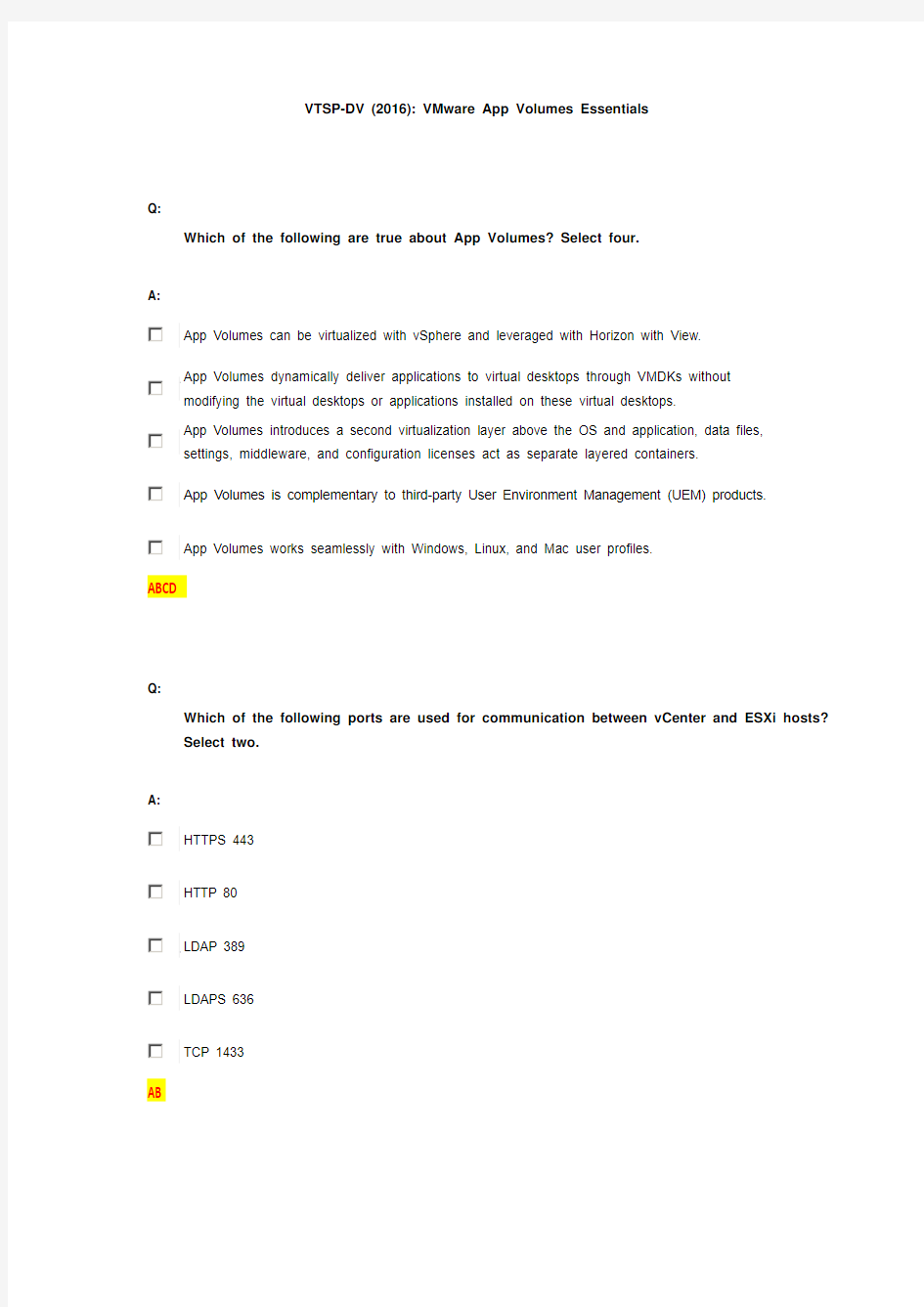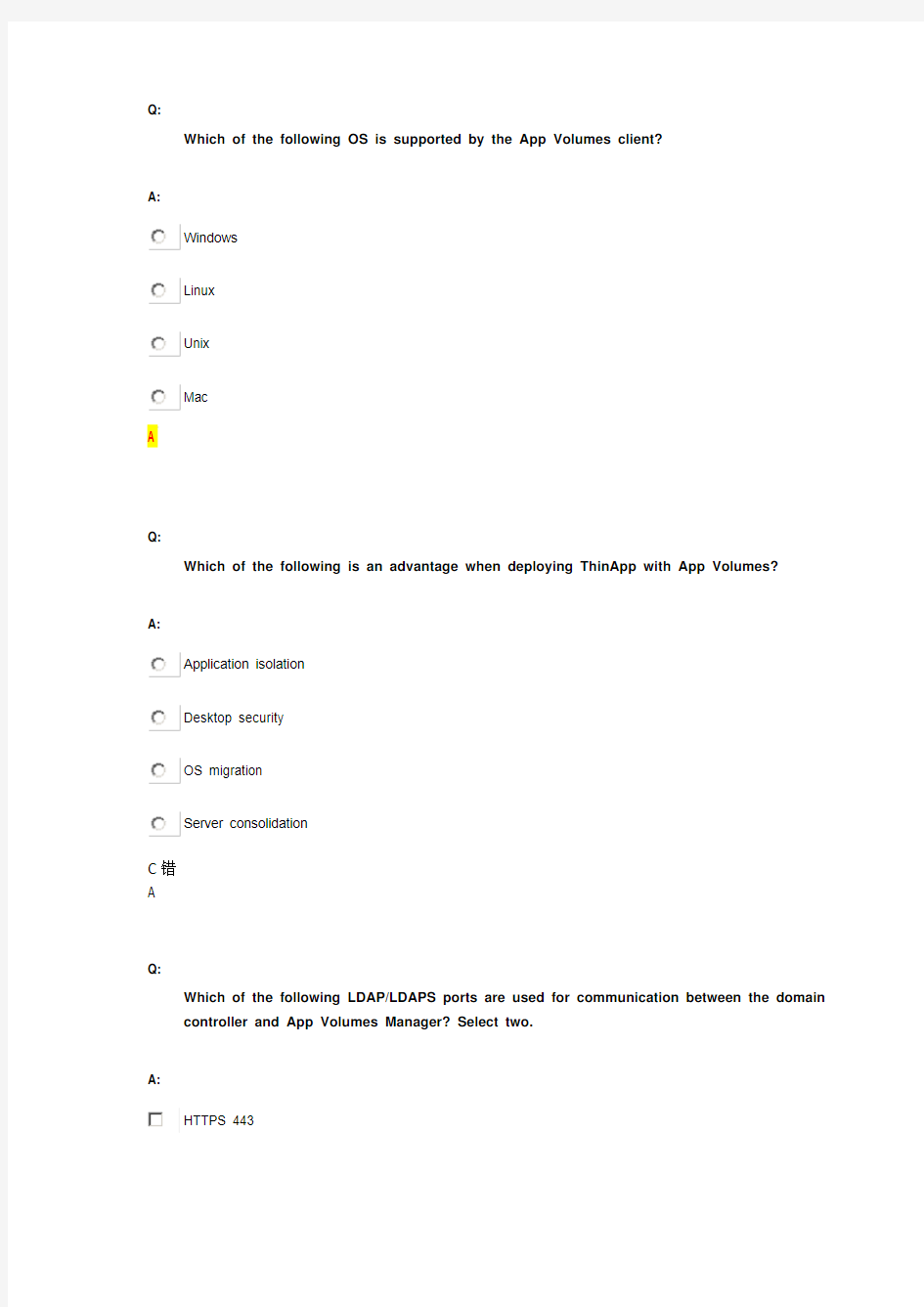VTSP-DV (2016) VMware App Volumes Essentials


VTSP-DV (2016): VMware App Volumes Essentials
Q:
Which of the following are true about App Volumes? Select four.
A:
App Volumes can be virtualized with vSphere and leveraged with Horizon with View.
App Volumes dynamically deliver applications to virtual desktops through VMDKs without
modifying the virtual desktops or applications installed on these virtual desktops.
App Volumes introduces a second virtualization layer above the OS and application, data files, settings, middleware, and configuration licenses act as separate layered containers.
App Volumes is complementary to third-party User Environment Management (UEM) products.
App Volumes works seamlessly with Windows, Linux, and Mac user profiles.
ABCD
Q:
Which of the following ports are used for communication between vCenter and ESXi hosts?
Select two.
A:
HTTPS 443
HTTP 80
LDAP 389
LDAPS 636
TCP 1433
AB
Q:
Which of the following OS is supported by the App Volumes client?
A:
Windows
Linux
Unix
Mac
A
Q:
Which of the following is an advantage when deploying ThinApp with App Volumes?
A:
Application isolation
Desktop security
OS migration
Server consolidation
C错
A
Q:
Which of the following LDAP/LDAPS ports are used for communication between the domain controller and App Volumes Manager? Select two.
A:
HTTPS 443
HTTP 80
LDAP 389
LDAPS 636
TCP 1443
CD
Q:
Which of the technique is recommended by VMware to provide availability and resiliency for App Volumes?
A:
Load Balancer
VMware HA
VMware FT
DRS
A
Q:
How many AppStacks are recommended per target system?
A:
20
30
40
50
A
Q:
Which of the following are features of App Volumes? Select four.
A:
Complete application lifecycle management
Dynamically deliver application sets
Customize and group AppStacks for LOBs
Cost optimized infrastructure
Dynamically allocate I/O capacity
ABCD
Q:
To which of the following can you provision an AppStack? Select four. A:
Computer objects
AD groups
OUs
Users
LDAP users
ABCD
Q:
In which of the following states does the App Volume Agent receive license information and machine assignments from the Manager?
A:
Startup
Shutdown
Login
Logout
C 错
Q:
TeoWare is an IT company that wants to cut IT expenditures. When analyzing the IT expenditure for the past financial year, Mathew, the IT Manager of TeoWare notices that most IT effort was consumed during the frequent deployment and patching of application.
Which of the following features of App Volumes will help TeoWare cut down on IT expenditure?
A:
Complete application lifecycle management
Writable volumes
Seamless end-user experience
Optimized desktop infrastructure
D 错
A
Q:
AirComp is a new IT company with 50 employees. The company consists of a software development team, testing team, and finance team. James, the CEO of AirComp, calls Patrick, the IT Manager of AirComp to explain that the company has signed a long-term project with a new client and are recruiting a few hundred people to work on the project.
James adds that the new employees will begin work from their first day of joining and that he wants the computers to be installed and ready with the required software and application. Which feature of App Volumes best suits this scenario? Select four.
A:
Dynamically deliver application sets
Writable volumes
Customize and group AppStacks for LOBs
Seamless end-user experience
Cost optimization
ABCD 错
ACDE
Q:
Which of the following defines App Volumes?
A:
A real-time application delivery system.
A lightweight tool for creating, editing, and running VMware VMs and virtual appliances.
A tool that abstracts the application from the underlying operating system and converts it into a
single executable file.
A product for managing server virtualization infrastructures.
A
Q:
Which of the following services should be installed when using App Volumes with Horizon with View? Select three.
A:
App Volumes Agent
App Volumes Manager
App Volumes Broker Integration Service
AppStack Volume
Writable Volume
ABD错
Q:
Which of the following are the components of App Volumes? Select four.
A:
App Volumes Manager
App Volumes Agent
AppStack Volume
Writable Volume
App Volumes Broker
ABCEACDE错
Q:
Which of the following is the landing page of the App Volumes Manager web interface?
A:
Dashboard
Volumes
Directory
Interface
A
Q:
AppStack can be created by importing VMDK files from the selected datastore.
A:
True
False
A
Q:
Which of the following credentials and permissions are required for provisioning and
installing App Volumes? Select three.
A:
Active directory users require an account with standard permission for initial setup and connection.
Administrator level account is required for provisioning AppStack VMs.
End users require administrator privileges to install application into their writable volumes.
User level access is sufficient for provisioning AppStack VMs.
End users can install application into their writable volumes user installed applications without administrator privileges.
ABEABE错
Q:
Which of the following is the minimum memory and CPU requirements for installing App Volumes?
A:
One vCPU and 2GB RAM
Two vCPUs and 4GB RAM
Four vCPUs and 2GB RAM
One vCPU and 8GB RAM
B
Q:
Which of the following defines the AppStack Volume?
A:
The file system and registry abstraction layer running on the target system.
The per user read-write volume, which retains the changes written in the user session.
The read-only volume containing single or multiple applications.
A powerful automated file system that simplifies storage management for virtual machines.
C
